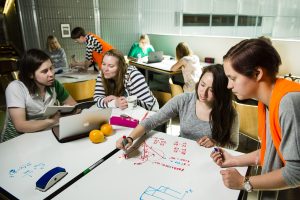In our study group, we read Tommy Dreyfus’ paper Why Johnny Can’t Prove. In the paper, he describes how beginning university mathematics students find it difficult to see the difference between different kinds of mathematical reasoning.
Often, teachers and textbooks use both formal and informal explanations to justify claims. Both are needed, and for an experienced mathematician it is easy to see which one is which. Students, on the other hand, may get confused and cannot form a clear picture on what is meant by a proof.
 This is how we came up with the idea of a proof hat. It makes it possible to distinguish between different kinds of justifications. When teacher writes a formal justification for a claim, he/she wears the proof hat. When a topic is discussed more informally, the proof hat is not used.
This is how we came up with the idea of a proof hat. It makes it possible to distinguish between different kinds of justifications. When teacher writes a formal justification for a claim, he/she wears the proof hat. When a topic is discussed more informally, the proof hat is not used.
It seems that the proof hat makes students pay attention to the different levels of justification, since if the hat is missing, they will let the teacher know. And it definitely brings cheerfulness to the classroom.
